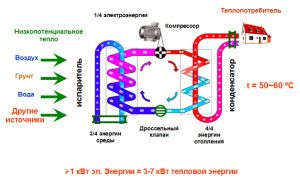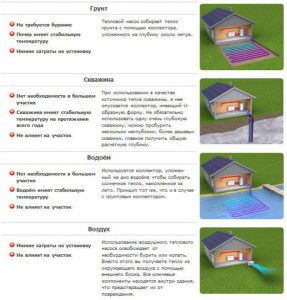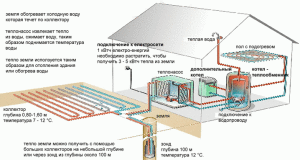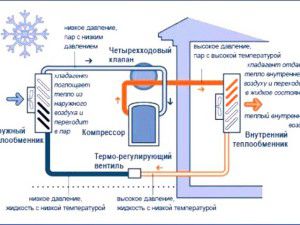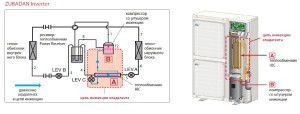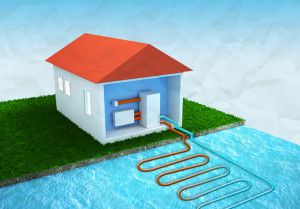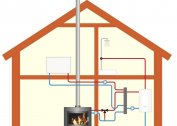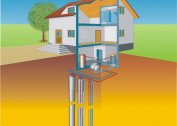Among all alternative heating systems at home, heat pumps are considered the best. They differ not only in design, but also in work efficiency. Therefore, to select the best model, you should understand the principle of the operation of heat pumps for heating a house.
The principle of operation of heat pumps
For a better understanding of the operation of the heat pump, you can consider its most common use case - in conventional refrigerators. In principle, air heat pumps for heating are slightly different. The difference is thermal energy, not cold.
You can find out how a heat pump works for heating a house after considering a general functioning scheme. To generate heat, the structure has an internal circuit through which refrigerant flows. It connects to the heating pipes of the house using a heat exchanger. Heat is received from an external source due to an additional circuit. Consider how heating works with a heat pump:
- The refrigerant is in a gaseous state. It receives thermal energy from the external circuit. Moreover, it is enough that the gas temperature rises to + 10 ° C.
- Increasing the pressure of the refrigerant in order to turn it into a liquid state. For this, air heat pumps for heating a house without fail have a compressor. In this case, the temperature of the liquid rises to + 65 ° C.
- Using a heat exchanger, heat is transferred to water in the heating system in the house.
- The throttle valve and drip reduce the pressure and thereby provoke the reverse transition of the refrigerant from a liquid to a gaseous state to repeat the process.
Is home heating efficient with a heat pump? In many cases, this system is installed as additional to reduce the cost of basic heat supply. One of the drawbacks is the inability to make heat pumps for home heating with their own hands with a normal efficiency indicator and reliability. For manufacturing, you will need to make complex calculations and choose the right materials. You can draw an analogy with household refrigerators - almost no one makes them on their own, preferring reliable factory models.
Almost all reviews of heat pumps for heating a house indicate a direct dependence of the heat source on the primary circuit on the efficiency indicator of the device.
Types of heat pumps for heating
The most important task when designing home heating using a heat pump is the choice of medium for heating the coolant in the primary circuit. There are several types of heating equipment of this type that can adapt to various heating mediums.
The most important condition is the ambient temperature. Since in practice it is not possible to make heat pumps for heating with your own hands - consider the selection criteria for factory models:
- Ambient temperature. It should be at least + 6-8 ° C. Otherwise, the efficiency of the air heat pump for heating will decrease to zero;
- Selection of coolant for the primary circuit. It can be water, soil or air. It is important that the first condition is met;
- Proper organization of heating with a heat pump - place of installation of heating. The best option would be to install the system in a heated, dry room. In this way, additional heat loss can be avoided.But at the same time, it is necessary to provide a coolant supply to the primary circuit heat exchanger.
It is because of the first point that air heat pumps for heating a house are inefficient. Exceptions are models with innovative heat transfer systems. However, their cost remains high.
Even modern models of air heat pumps for heating a house cannot provide the proper level of heating of the coolant when the temperature in the street drops to -15 ° С.
Geothermal pump for heat supply
Reviews of heat pumps for geothermal heating carry the most positive recommendations in terms of operation and efficiency. Their primary circuit is located in the ground, which gives a number of advantages.
The disadvantage is the complexity of arranging this type of heat supply. Unlike do-it-yourself air heat pumps for heating, it will take a lot of effort to install the primary circuit. There are two ways to position the outside trunk:
- Horizontal. Pipes are located below the level of soil freezing. For proper operation of the system, the distance between highways should be at least 15 cm;
- Vertical. Wells up to 50 m deep are drilled to install pipelines. Reviews of heat pumps for heating a house indicate high reliability of equipment operation, regardless of outdoor temperature.
Before choosing equipment, it is necessary to analyze the characteristics of the soil - its freezing level and composition. The operation of a heat pump for heating a house directly depends on the degree of heating of the coolant in the primary circuit. Therefore, the temperature of the soil should be at least + 7 ° C.
You can make a low-power heat pump for heating yourself. To do this, use a compressor from the refrigerator. But the piping system and the injection of freon into the circuit should be entrusted only to professionals.
Air-to-air heating system
According to a similar principle, air heat pumps operate to heat the house. The difference is the use of street air as the primary coolant.
One of the disadvantages of this equipment is the inability to connect to water heating at home. Heat transfer from the compressed refrigerant at the air heat pump for heat supply takes place immediately in the room. Alternatively, you can install a chiller-francoil system that works on the same principle. But its cost is very high - an acquisition of 24 kW will cost at least 900 thousand rubles.
Why is home heating using an air heat pump becoming more popular? There are several reasons for this:
- Simple installation. In terms of complexity, it is no different from installing a split air conditioner;
- The operation of the heat pump for heating the house and for cooling;
- Fewer loops affect system reliability.
But is it possible to operate this heating in regions where low temperatures are observed in winter? To do this, it is necessary to carry out heating using a heat pump with an additional module - an injection line.
It automatically adds refrigerant to maintain the normal functioning of the main circuit. Thus, the optimal operation of the equipment is achieved even when the air in the street drops to -15 ° C.
In reviews of heat pumps for air heating, special attention is paid to the location of the indoor unit in the house. It should supply hot air along the room.
Water-to-water pump for heat supply
For regions with warm winters, installation of pumps is recommended, in which a reservoir is used as the primary circuit. It is important that the temperature in it does not fall below + 7 ° C.
The main advantage of this system is the quick installation and dismantling of the flexible piping system. To do this, you need to think in advance of the material for the manufacture of highways. The best option is the use of pipes made of cross-linked polyethylene with an additional airtight layer.
Such systems are used to heat the house during a period when the temperature in the street does not fall below -7 ° C. Water-to-water heat pumps have also been used to cool air in the summer or provide hot water.
When installing the external circuit, make sure that there is no bending of the lines. Otherwise, the movement of the coolant will stop.
Heat Pump Reviews
Familiarization with real estimates of the operation of the heat pump is one of the current tools to determine the feasibility of its acquisition and installation. Part of the negative reviews about heat pumps for heat supply at home is due to installation and operation errors:
- After a long analysis of offers on the market, we decided to purchase a heat pump for our home. We chose a vertical system of ground-air. After analyzing the soil on the site, it turned out that we have a high water level. For a heat pump, this is even better - instead of 30 m. The depth of the well was done 12. The system has been working without complaints for the second year already;
- In the heating project, the cottages with the help of a heat pump were designed to heat water in pipes to + 70 ° C. In fact, it did not rise above + 50 ° C. In addition, the payback time was about 15 years. Now, after the first month of work, the situation has improved somewhat. But all the same, additional heating is needed - gas or with a solid fuel boiler. We are thinking about choosing and installing.
Should I install a heat pump for heating a private house? If finances allow - certainly, yes. But first you need to choose the right model of equipment and contractor for its installation.
For acquaintance it is recommended to watch a video about the installed water-air heat pump:
